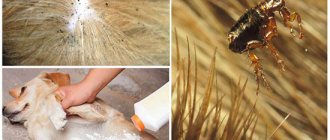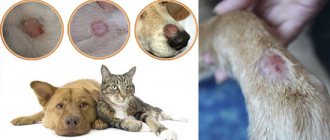Related Posts
- Flea: all the facts about parasites
- How to treat a carpet to get rid of fleas at home?
- Special flea drops for kittens - a guarantee of safety and effectiveness
Allergy is the body's hypersensitivity to antigens. The disease manifests itself when an allergen penetrates into the blood through the mucous membranes, skin or respiratory system.
Allergies can develop in humans and any animal, including dogs. Pets often suffer from dermatitis caused by a flea bite. The saliva of parasites contains substances that provoke hypersensitivity reactions.
These include rash, swelling, sneezing, watery eyes, or itchy skin.
Failure to treat these symptoms often leads to the development of more dangerous skin diseases. Sometimes the animal dies due to anaphylaxis, cardiac or respiratory failure.
Therefore, when an allergy appears, it is important to immediately get rid of fleas and carry out comprehensive anti-allergy therapy.
Symptoms and behavior of animals
Manifestations of flea allergy can be noticed by the rapidly changing behavior and condition of the pet. Symptoms of flea dermatitis in dogs:
- Severe itching. The dog itches continuously, which leads to redness of the skin and the appearance of abrasions and open wounds on it.
- Dandruff. Small white flakes can be seen on the fur.
- Unpleasant odor emanating from the body and mouth.
- Lack of appetite.
- Digestive system disorders: frequent constipation or prolonged diarrhea, nausea and vomiting.
- Formation of edema on the mucous membranes.
- Dryness and flaking of the skin.
The pet's behavior changes radically: it becomes lethargic, refuses to go out, ears droop, and constantly wags its head.
Self-diagnosis
The owner can determine the presence of an allergic reaction to parasites in a dog independently through a thorough examination. Fleas choose to settle on the rump, stomach, root of the tail and inner thighs. When an allergy develops, the animal begins to intensively scratch these areas. Having parted the fur, the owner will find a large number of fleas and nits. The latter are not difficult to identify: they look like a small black dot and can be easily removed from the animal’s fur with your fingers. Female fleas, engorged with blood, are brown in color and have a large body.
The combination of a large number of parasites, constant itching in the animal and the presence of inflammatory foci with purulent contents on the body indicate that the dog is allergic to flea bites.
There are situations when a dog has only a few parasites on its body; the rest hide in carpets and upholstered furniture, periodically attacking the animal. Even if the owner has no doubt that the pet is allergic to flea bites, before starting treatment, it is necessary to show the animal to a veterinarian to clarify the diagnosis.
Symptoms and diagnosis
One of the most common symptoms is itching, which can manifest itself in a variety of ways—dogs may scratch with their paws, chew or lick themselves, roll on their backs, or rub their sides, rump, and base of their tail against walls and sofas. At the same time, the severity of itching is not proportional to the number of fleas: with increased sensitivity to flea bites, only a few parasites hiding in thick fur may be present on the dog. It is important that when flea allergic dermatitis develops in dogs, itching may be present for several weeks and even months after treatment of the dog and the environment
effective flea treatments for dogs.
Detecting adult fleas on a dog is not always possible, especially in dark-colored dogs with thick fur. Most often, fleas are found in the abdomen, neck, rump and base of the tail. The paw area is usually not affected by flea bites, however, exacerbation of allergic reactions, such as atopic dermatitis and associated pododermatitis (inflammation of the skin between the toes and paw pads), is possible due to flea infestation.
At the sites of flea bites, you can find pinpoint red lesions surrounded by a border. In particularly sensitive dogs, the lesions may appear edematous (swollen) and persist for several days after the bite. As a result of excessive licking of bite sites, a secondary bacterial skin infection may develop, manifested by purulent discharge, crusts and ulcers, and possibly an unpleasant odor. Itching and inflammation of the skin leads to hair loss. With a long course of flea allergic dermatitis, thickening and hyperpigmentation (blackening) of the skin develop. Also, the fur can change its color (from white to red, from black to brown) under the influence of constant licking.
The location of the lesions usually corresponds to the areas most susceptible to flea bites (tail, area around the anus, thighs and abdomen), and lesions may also spread along the back, sides, armpits and neck.
Photo. Skin lesions in a dog with itchy abdominal area associated with flea bites (redness, hair loss, areas of hyperpigmentation)
Photo. Skin lesions (hair loss, redness, crusting) in the armpit area of a dog caused by an allergy to flea bites and secondary bacterial infection
Photo. Hair loss, scabs, red skin and itching in the tail and rump caused by flea bites in a Boston Terrier
Sometimes you can see flea feces in the fur - small black grains. Because they contain remnants of coagulated blood, flea feces turn reddish-brown when wet. This is used in wet paper dough.
The detection of segments of the cucumber tapeworm helminth Dipylidium caninum in the dog’s feces or on the skin near the anus indirectly indicates that the dog is infected with fleas, since this helminth is transmitted only through fleas and their larvae.
When detecting signs of a dog being infected with fleas, owners often turn to the Internet with the request “fleas in dogs, symptoms and treatment” or “dog has fleas, what to do,” where they can find a lot of advice. The most accurate and effective method for diagnosing a dog's flea infestation is trial antiparasitic treatments.
However, flea infestation and flea allergic dermatitis must be differentiated from other parasitic diseases, for example, from infection with cheyletella (“walking dandruff”) or lice eaters. Baldness and skin changes may also be associated with dermatophytosis (tinea versicolor), bacterial folliculitis, or Malassezia dermatitis, which is caused by yeast. Itching without obvious signs of lesions may be associated with other allergies, particularly food allergies and atopic dermatitis. Therefore, it is recommended to consult a doctor for diagnosis and treatment.
How dangerous are flea bites for humans?
Parasites are able to coexist with a person in his home for years. In addition to painful bites and unpleasant red spots, fleas can transmit dangerous infectious diseases. Their treatment can take a lot of time and a large amount of money. Here is a list of the most dangerous viruses ever carried by fleas:
- Typhus : the infected person has a high fever, vomiting, and aches.
- Brucellosis : the disease seriously affects the human nervous system, the temperature rises. Often the disease develops into more acute forms. This leads to arthritis and disruption of the reproductive system.
- Anthrax : the patient's body becomes covered with non-healing ulcers. The infection affects internal organs and is fatal.
They say that fleas can carry the pathogens of dermatitis , hepatitis and encephalitis . An attack by parasites can trigger allergies .
Frequent flea bites have a detrimental effect on the nervous system . Because of this, constant phantom pain occurs. At this moment the person feels a sharp prick, but the bite mark does not appear. Some people even start to itch their entire body at the mere thought of insects. In this case, only complete disposal of parasites using specialized means and sedatives will help.
How a flea bites
A person experiences a sharp stabbing pain when bitten by a flea, this is explained by the fact that, unlike bedbugs and ticks, the flea does not inject an anesthetic at the time of its bite. Thanks to special enzymes that block blood clotting, which the flea injects during a bite, human blood flows through the wound into the flea's stomach in a thin stream almost by itself. When the flea detaches itself from the bite, the elastic walls of the skin will close and prevent bleeding from escaping.
A painful bite is the least of the evils that a flea can cause.
Danger and possible consequences
Allergies in dogs require immediate treatment, since the disease can cause a number of complications and serious consequences. Intensive scratching of the skin leads to the appearance of open wounds, in which a favorable environment is created for the development of pathogenic microflora that comes from the outside or is brought in by the parasites themselves. This leads to the appearance of purulent-inflammatory processes that provoke severe intoxication of the animal.
Late treatment of allergies can lead to dermatitis becoming chronic with frequent outbreaks of relapses. A weakened animal’s body and a depressed immune system can lead to consequences such as heart or respiratory failure. Untreated parasite allergies often lead to the death of dogs.
Formation of wounds due to flea bites.
Main symptoms
Flea allergy is a pathology that occurs quite often. This is a reaction to allergens present in the saliva of insects. The main features of this type are:
The environment also often causes allergies in living beings. These are flowers, fibers of natural materials, mold, dust mites. If the allergen is always in the house, then the pet’s reaction will be constant. In other cases, the disease manifests itself seasonally.
There are two types of environmental allergies:
- Atopy is a hereditary tendency to allergies to the external environment. This is the most common type. Mostly seasonal atopic dermatitis is observed. Seborrhea and dry skin appear.
- Contact allergy. Formed due to the interaction of a dog with an object where the allergen is located. Usually seen on the paws, face, and stomach lining.
Features of the course of allergies
The reaction to flea saliva in dogs is related to the season of the year. Most often, an allergy outbreak occurs in spring and summer. Signs may appear immediately after the bite or be sluggish, it all depends on the degree of sensitivity of the body. But in most cases, reactions occur due to numerous bites and prolonged presence of parasites on the animal’s body.
The first sign is itching, which can last from several hours to 2 days. Other symptoms:
- deterioration of skin condition;
- changes in general condition and behavior: appear after several weeks or months, depending on how sensitive the animal’s skin is.
In order to detect the disease in time and prevent the condition from worsening, you need to immediately respond to the appearance of prolonged itching in your pet. Timely examination and provision of veterinary care will help save the dog not only health, but also life.
Treatment of allergies to flea bites in animals
Naturally, curing allergies is only possible if there are no factors that provoke the disease. The first guarantee of recovery is the complete and merciless destruction of fleas in the animal’s fur, at the resting place and throughout the home. The room is treated with quickly evaporating insecticides designed to kill and stop the growth of crawling insects.
Note! If you have several animals, preventive flea treatment should be carried out simultaneously for all, whether all pets are itchy or just one.
Depending on the severity of the animal’s condition, a flea removal agent is determined. Considering that many insecticidal drugs are not recommended for use if the animal has wounds and scratches on its body, the choice of drugs is quite narrow and specific. Most often, at the stage of baldness of the dog’s croup, dermatitis is also diagnosed in parallel with allergies.
The treatment is prescribed:
- Complete removal of fleas. Due to the affected area and speed of action, sprays are most often used.
- Rest and hypoallergenic diet.
- Local skin treatment - treatment with ointments, drying creams.
- Antihistamines for partial relief of itching.
- For anemia - iron supplements, immunostimulants.
- In advanced forms and in the presence of dermatitis - glucocorticoids (synthetic or natural hormones of the adrenal cortex).
Important! Never use used motor oil, technical sulfur or other toxic substances as “ointments”. Yes, these methods were used in the century before last, but only because there were no alternatives!
Allergy to flea saliva is a genetic trait in dogs. There is a list of breeds that are supposedly at particular risk, but in fact, all dogs suffer from the disease. The course of the disease and the rate of progression, but not the fact of an allergic reaction itself, may depend on breed predispositions. There is an opinion that allergies worsen with age. The assumption is logical, given the slower metabolism and decreased level of immune defense in older dogs.
Important! An allergy to flea saliva does not go away on its own. An animal prone to an acute reaction to parasite bites must be provided with complete treatment and prevention.
Which breeds are more susceptible
Flea dermatitis can occur in any dog, without exception, regardless of gender, age, or breed. The severity of the disease depends on the individual characteristics of the body, the rate of progression and the severity of the allergic reaction.
Dermatitis caused by flea bites is most often diagnosed in representatives of short-haired breeds - dachshunds, Labradors, bulldogs, boxers, Rottweilers, German shepherds.
Actions for anaphylactic shock
A large accumulation of parasites on the body and numerous bites can provoke anaphylactic shock, leading to the death of the animal without proper assistance. In this condition, the dog must be urgently taken to a veterinary clinic. If you can’t do this quickly, you can save your pet’s life by providing the correct first aid:
- If the dog is conscious and able to swallow, it should be given an antihistamine. The medicine will help reduce the intensity of symptoms.
- Breathing is accompanied by gurgling sounds - a sign that the lungs are filling with fluid. If the animal is conscious, it must be taken by the hind legs and lifted, holding in this position for 10 seconds.
- The dog is not breathing - artificial respiration is required. The pet should close its mouth and inhale air quickly and rhythmically 2 times into its nose. In 1 minute you need to take 15 to 20 breaths into the nose until the animal begins to breathe on its own.
Anaphylactic shock in a dog. After all the manipulations have been completed, take the pet to the hospital. At the veterinary clinic, the animal is administered anti-shock and potent antihistamines, and symptomatic therapy is provided if necessary.
Prevention
It is quite simple to protect your pet from infection by insects of any kind, if you do not forget to carry out regular preventive treatment of the dog and the room in which it is kept.
Specific actions for prevention:
- Processing with special means . Use flea shampoo regularly when bathing. Once a month, apply drops or spray, or wear a special collar.
- Limiting contact with homeless people and obviously infected animals. Choose places for walking away from possible breeding grounds, which are trash cans and places where dogs constantly gather.
- Weekly wet cleaning of the house and monthly special treatment against parasites . Fleas often only feed on the host; they prefer to live and reproduce in more secluded places. Therefore, treatment with insect repellent compounds is carried out regularly. At home, a solution of vinegar or citrus fruits in water is perfect for this.
- When accepting a gift of another animal's belongings, find out whether the animal has ever been sick. In any case, subject them to heat or special treatment, since flea eggs may not be visible to the naked eye.
Regular high-quality prevention will protect your pet and family from parasites and significantly reduce the risk of contracting many diseases carried by fleas.
Fleas on dogs - what to do?
Fleas are one of the most common dog parasites. These blood-sucking insects not only cause the animal a lot of discomfort, but can also have a detrimental effect on its health. When a flea bites a dog, it causes pain, but its saliva, which is a breeding ground for pathogens of various diseases, is much worse.
That is why every dog owner is faced with the task of identifying these parasites as early as possible and ridding the pet of them as quickly as possible.
So where might your dog get infected?
Honestly, anywhere: in the yard, park, at the dacha, in the basement of the house. If a dog infested with fleas has been running around in the yard, your dog may have contracted the parasites.
Fleas can get on your dog from the grass. They are very tenacious and are able to wait for their prey for a long time, climbing onto blades of grass. Jumping 30-35 cm in height and up to 20 cm in length, fleas easily reach the dog’s fur. Larvae are also dangerous.
They fall from an infected dog to the ground, and then often end up in the house, sticking to the soles of shoes and even on clothes.
Often in the fall, with the onset of cold weather, fleas begin to migrate from cold basements to apartments. And this is already a threat for dogs that rarely go outside. And for the owners too.
Why are fleas dangerous?
Flea bites cause the following problems:
- Severe itching and, as a result, scratching at the bite sites. Further, various skin diseases develop at the site of scratching.
- Together with particles of blood, fleas can transmit all the diseases of the animal on which they previously lived (typhoid, distemper, tularemia - and that’s not all).
- Infection with worms. Fleas act as intermediate hosts for some types of helminths.
- In weakened, elderly dogs and small puppies, due to flea infestation, the body can be severely depleted, which contributes to the development of anemia, which can be fatal.
How can you tell if your pet is infected?
Any attentive owner will immediately understand that something is wrong with the dog:
- The animal constantly scratches furiously and bites something in the fur, while the characteristic chattering of its teeth is clearly audible.
- The pet behaves extremely restlessly, jumps up sharply, does not lie down or sit in one place for a long time. Often arches his back and freezes in this position for several seconds.
- Upon careful examination, small black insects or their white and black eggs, similar to balls, are noticeable on the dog’s skin.
What to do if your dog gets fleas?
The most important thing is don’t panic. As soon as parasites are discovered, begin treatment immediately to avoid their spread throughout the apartment.
- Treat your pet with flea medication. The veterinary pharmacy will tell you which product is best to purchase (depending on age, weight, breed, etc.).
- Brush and bathe your dog thoroughly using flea shampoo. Carry out all manipulations in the bathroom. After a few days, according to the instructions, re-treat (strictly follow the instructions for using the flea remedy) - this is necessary in order to destroy the fleas that hatch from the remaining eggs.
- After about a month, repeat the treatment to prevent re-infection of the dog.
- Boil the bedding and objects on which fleas and their eggs could remain (rugs, toys, fabric coverings of the carrier, etc.). Of course, it’s better to throw everything away and replace it with a new one to eliminate the risk of re-infection, but if this is not possible, boil it.
- Clean the room thoroughly: vacuum, wet clean with special detergents. Pay special attention to hard-to-reach places, as flea eggs along with dust can get trapped in floor cracks, under baseboards. Clean your carpet and rugs.
- 2-3 days after treatment, put a flea collar on your dog or use special flea drops for dogs. Follow the instructions included with the collar or drops carefully. Don't ignore this advice, it's important.
- Be sure to give your pet anthelmintic medications, since fleas are often carriers of worm eggs.
Important! If there were a lot of fleas and their attack caused skin problems, do not be lazy, contact your veterinarian to prescribe treatment. Dermatosis is a very unpleasant disease that causes a lot of trouble.
But in this article I talked about how to protect dogs from ticks
Prevention
Of course, it is easier to prevent a dog from becoming infected with fleas than to fight them later.
That's why:
- Keep your home clean and do wet cleaning regularly. Require your property management company to treat your basements for fleas.
- Periodically examine your pet after walks, especially in the spring and summer.
- Use special anti-flea products (sprays, drops, washing gels and shampoos, insecticidal collars).
- Make sure your dog does not have contact with stray dogs.
It is unrealistic to completely protect your dog from fleas, but it is quite possible to reduce the risk of infection.
Anton Koteikin, a consultant for the Samizoo.ru online store, was with you.
Allergy treatment
Treatment methods are selected depending on the severity of the symptomatic picture. But the first thing the owner needs to do is rid the animal of parasites using special shampoos and drops. In addition to cleaning the dog's skin and fur from fleas, it is recommended to disinfect all furniture in the house, carpets and bedding that may contain them.
A diet is required. When feeding a dog with ready-made commercial diets, it must be switched to hypoallergenic food. If the pet is on a natural diet, the veterinarian selects the menu for her.
Drug therapy
When treating flea dermatitis, antihistamines are necessarily prescribed to inhibit the effect of the hormone histamine and relieve the signs of pathology. The following drugs are used in therapy:
- Diphenhydramine. The drug eliminates inflammation and relieves allergic reactions.
- Cyprodine. This is an oral medicine. Cyprodine eliminates fever and relieves severe itching.
- Diprazine. Release form: tablets and solution for intramuscular administration.
- Astemizole. The medicine should not be given to pregnant dogs.
If the allergy is advanced and antihistamines do not give a positive result, the animal is prescribed glucocorticosteroids. To restore the body depleted by allergies, vitamin complexes, immunomodulators and supporting drugs that contain iron are used.
Folk methods of struggle
Along with taking medications, traditional methods of therapy can be used in the treatment of flea dermatitis. To speed up the healing process of the skin and relieve itching, it is recommended to treat the affected areas of the skin with decoctions based on medicinal herbs: chamomile, calendula, coltsfoot, comfrey and sage.
All decoctions are prepared according to the same recipe:
- 1 tbsp. l. the selected herb is poured with a glass of boiling water.
- The liquid is infused until it cools completely, after which it is filtered.
- A cotton pad is moistened with the decoction. They treat the skin carefully, without pressing too hard.
Aloe heals skin well. It is recommended to grind the cut leaf of the plant into a paste and apply it to the skin for 30 minutes. Since aloe has a pronounced laxative effect, it can be used in areas where the dog cannot reach with its tongue.
Aloe juice purchased at a pharmacy can be added a few drops to your pet’s food. This will help improve digestion and strengthen the immune system so that the body can independently resist allergens, thereby reducing the intensity of symptoms of the disease.
Echinacea is another effective remedy for treating flea dermatitis in dogs. Gauze, folded several times, should be moistened in it and applied to the damaged area. Keep the compress for up to 30 minutes.
It is important to remember that traditional methods cannot be used as the only method of treating flea allergies in dogs. Such treatment is only an addition to the main drug therapy.
Flea dermatitis. Dogs are allergic to fleas. What to do?
We can observe a dog or cat with a lot of fleas that run after each other, and at the same time the dog practically does not react, we can say that it practically doesn’t care, it may scratch a little and that’s all. And in another case, we don’t find a single flea, or one or two have run through, and the dog has terrible itching, there are some changes on the skin, there may be ulcers, pimples, baldness, areas may be completely swollen on the skin, scratching - in in general, all signs of changes and damage to the skin.
Why is this happening?
If we draw an analogy, we can compare it with a disease such as an allergy to ragweed. One person may be allergic to ragweed pollen while another person may not. Something similar happens in this case with both cats and dogs - with animals in general. For the same reason, flea dermatitis appears. It is also called allergic flea dermatitis. Therefore, do not be confused: when an animal has a flea infestation, it does not necessarily have to have flea dermatitis. And at the same time, there may be no fleas, but dermatitis is observed.
Why, if there are no fleas, then who bites the dog? The fact is that now, at the end of summer, the beginning of autumn, it is warm and humid. These are favorable parameters for the development and reproduction of fleas. Therefore, when you go out for a walk, a flea can attack your dog, bite, make one or two bites and run away. You won't even notice this flea. A few bites are enough for dermatitis to develop, a reaction appears in the dog and it will continue for several weeks. This is an allergic reaction.
So how can we help? The fact is that there is practically no treatment that we can apply and get rid of flea dermatitis. It's like any allergic reaction in the same person or animal. But we can help. We can apply several such options. In general, we can improve feeding, improve maintenance, that is, take all measures to make life easier for the animal and make it as healthy as possible. Because a healthy animal can more easily fight any disease, including allergies. Secondly, we can use some medications that will alleviate the condition. Antihistamines such as loratodine, diazolin, diphenhydramine, tavegil, suprastin - mass are used. Why are they called all antihistamines? Because in the process of allergies, a substance called histamine is released, it plays a leading role - swelling, itching and other signs of allergies. But antihistamines work well in humans, but they are not so effective in animals. Because besides histamine, there are a number of substances that are released during allergies in animals. Therefore, you can use antihistamines for animals, but do not expect the same effect as in humans. It is possible, but ineffective.
Following. Calcium preparations are used - calcium gluconate or calcium chloride. It is administered intravenously. When administered intravenously, the dose of calcium is determined individually, so I won’t tell you exactly how much you need. And during the action of calcium, adrenaline is released, it acts on the adrenal glands, other mechanisms are activated, which are still not reliably known. But this leads to a decrease in vascular permeability, swelling decreases, the body’s reactivity to the allergen decreases, and the animal feels better.
The next drug that can be used is sodium thiosulfate. It slows down the development of the reaction, it is also administered intravenously, and can be injected for a course of 7-10 days. There are different schemes, from small to large doses or, conversely, from large to small. If you are interested, I can talk about this separately. It is used to slow down the development of the reaction and sometimes it is possible to completely eliminate the animal’s allergy for a long period of a month or two. Not always, but you can fight like this.
The third group of drugs are hormones. Prednisolone, dexamethasone, execan, dexafort and others are used. These are all hormonal drugs that work well. You applied it and, one might say, it works before your eyes. But it has a lot of side effects. All adrenal hormones suppress the immune system, the immune system weakens. They can act on the gastrointestinal tract, they can cause irritation or perforation of the intestines, or bleeding can occur, they affect vision, metabolic processes, carbohydrate metabolism, and the “Water Lily” syndrome can develop when the animal gains excess weight. Hormones have a lot of side effects. If used in a short course for a short period of time, these side effects do not have time to develop, but when the animal is constantly kept on hormones, this leads to serious complications. Therefore, be careful with hormones and use them as a last resort. The average dose, if you take prednisolone, is 1 milligram per kilogram. Usually they start with a large dose and gradually reduce it to a small dose that works. Let’s say you started with five tablets of prednisolone, then drop one tablet at a time and work your way up to one tablet. And so keep the animal on hormones for about ten days. All this is averaged and these hormones need to be prescribed individually in each case.
These are the main directions for making life easier for an animal with flea dermatitis. And, of course, you need to constantly get rid of fleas both on the animal and in the environment. As I said, all the same, these drugs are ineffective, which you drip on the dog, you will only get rid of fleas, but will not get rid of dermatitis, but they need to be used. Because the fewer fleas, the less likely you are to be bitten, and the less likely you are to develop an allergy. Therefore, regularly and continuously, as the instructions say, you need to apply drops to the withers, collar, then treat the apartment, the room where the dog lives, and try not to walk where there is a lot of dry grass, because fleas live there. This problem will remain relevant until the cold weather sets in. It will get colder to 10 degrees, and then most of the fleas will go into hibernation, and the animals will feel better.
Also, friends, we are back again to the anal glands. I mention them in almost every video. The fact is that if you properly care for the anal glands, they affect the proper functioning of the skin, and it will become easier for animals to tolerate this. This will not get rid of flea dermatitis, but if the anal glands are working properly, it will be easier to tolerate this allergy.
That's it, friends, we talked about flea dermatitis, if you have experience in dealing with this disease, share it in the comments, I will be pleased, it will be useful for our viewers too. Bye, friends!











